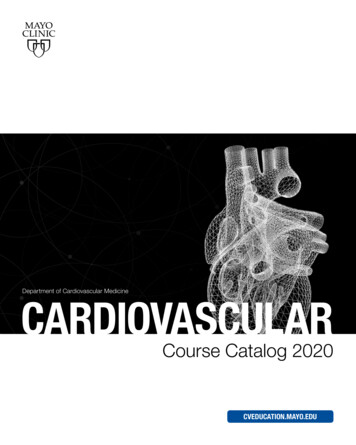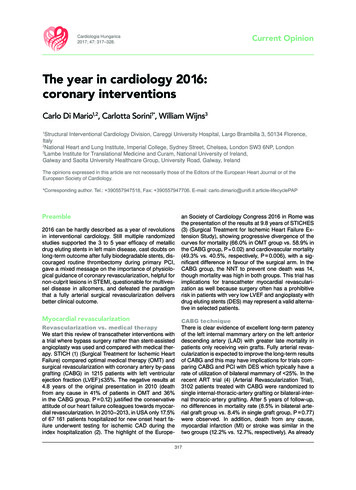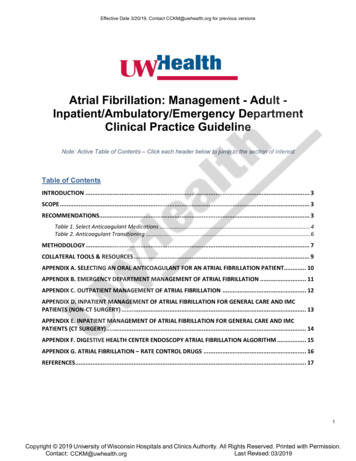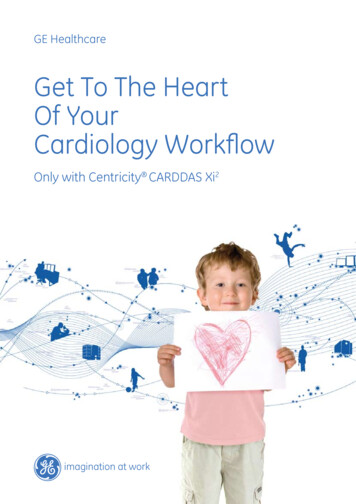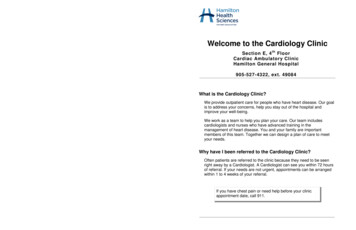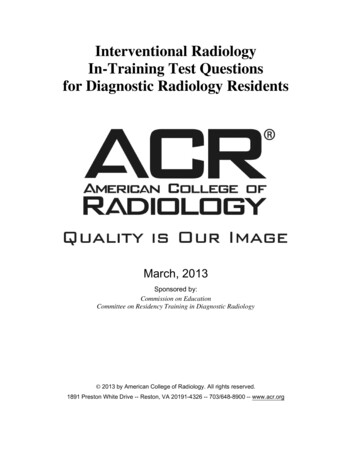
Transcription
Interventional cardiology board review questions pdf 2017 free pdf download
Basic Information: Year: 2018 Page Number: 552 File Type: PDF File Size: 30.72 MB Authors/ Editiors: Debabrata Mukherjee With two new editors and hundreds of new questions, this comprehensive new edition of 1133 Questions: An Interventional Cardiology Board Review, continues to serve as the perfect study aid for anyone taking the AmericanBoard of Internal Medicine (ABIM) interventional cardiology board exam, either for the first time or to recertify. You’ll have everything you need—detailed answers and explanations for each question and plenty of relevant images—to pass the exam and improve your ability to provide effective and evidence-based patient care. I overall liked it as anadditional question source for interventional boards recert exam. CathSAP questions seemed overall more boards-relevant but still a lot of good topics and even though many questions focused on minutiae that are probably not boards-relevant, it still provided decent questions for review. I really liked that the questions were also available in an online format (select answer, submit then immediate scoring of the question plus explanation) but there were a few chapters where the publisher messed up the online answer key. Chapter 24 was especially problematic. Not a huge deal because you can cross-check with the book hard copy, which did not have the same errors but still is something thepublisher should have fixed by now. Good collection of thought provoking clinical cases.good for clearing exams and for preparation to handle such cases as when encountered. Free Download 1133 Questions: An Interventional Cardiology Board Review 3rd Edition in PDF format 1133 Questions: An Interventional Cardiology Board Review 3rdEdition PDF Free Download Download 1133 Questions: An Interventional Cardiology Board Review 3rd Edition 2018 PDF Free 1133 Questions: An Interventional Cardiology Board Review 3rd Edition 2018 PDF Free Download Download 1133 Questions: An Interventional Cardiology Board Review 3rd Edition PDF ABIM updated the InterventionalCardiology MOC exam blueprint (pdf)—the exam content outline—to ensure the exam reflects what interventional cardiologists find most important. The new blueprint will be used to update the MOC exam starting with the Fall 2017 administration. An invitation to review the MOC blueprint was sent to all interventional cardiologists holding validcertification in the field. Participants were asked to rate the frequency of blueprint topics in their practice and the importance of individual tasks (e.g., diagnosis, patient care) within those topics. Their ratings informed adjustments to the distribution of medical content areas. The updated MOC blueprint shows which topics were rated low-frequencyand reports the importance ratings for all topics and tasks in the blueprint. The updated blueprint also describes how ABIM is using the ratings to update the MOC exam by emphasizing high-importance content and limiting low-frequency topics. Exam Content The detailed Interventional Cardiology Maintenance of Certification exam blueprint (pdf)includes content areas covered, their relative percentages and the approximate number of questions in each area to expect on a typical exam. Exam Administration Multiple editions, or “forms,” of the exam are used, and they may differ in question order and content. Some questions require the interpretation of illustrative materials such aselectrocardiograms, radiographs and photomicrographs (e.g., blood films, Gram stains, urine sediments). Exam Development A complete description of the process used to develop ABIM exams is available in How Exams Are Developed. Topics include: Pretesting Question content criteria Question-writing process Question review/editing processRelevance review Question Format The exam consists of single-best-answer questions only. This type of question consists of a brief statement, case history, graph or picture followed by a question and list of possible options. You must choose the one answer that is better than the others; note that other options may be partially correct. Familiarizingyourself with the question format in advance may help you work more effectively. Take the tutorial. Copyright and Examination Non-Disclosure Policy All ABIM materials are protected by the federal Copyright Act, 17 U.S.C. § 101, et seq. Access to all such materials, as further detailed below, is strictly conditioned upon agreement to abide by ABIM'srights under the Copyright Act and to maintain examination confidentiality. ABIM assessments are confidential, in addition to being protected by federal copyright and trade secret laws. Candidates and diplomates who undertake assessments agree that they will not copy, reproduce, adapt, disclose or transmit assessments, in whole or in part, beforeor after taking an assessment, by any means now known or hereafter invented. They further agree that they will not reconstruct assessment content from memory, by dictation, or by any other means or otherwise discuss assessment content with others. Candidates and Diplomates further acknowledge that disclosure or any other use of ABIMassessment content constitutes professional misconduct and may expose them to criminal as well as civil liability, and may also result in ABIM's imposition of penalties against them, including but not limited to, invalidation of assessment results, exclusion from future assessments, suspension or revocation of Board Certification and other sanctions.With respect to ABIM's Maintenance of Certification (MOC) products, including its medical knowledge modules and ABIM PIMs Practice Improvement Modules , candidates agree that they will not copy, reproduce or make any adaptations of such materials in any manner; and will not assist someone else in the infringement or misuse of these or anyother ABIM-copyrighted works. Are you starting to study for your Interventional Cardiology Certification Exam? The pass rate for the exam is 90% but is known to be a challenging test. Don’t panic, there are many things you can do to prepare such as devising a study plan, talking to people who have taken the exam, and testing yourself with practicetests. Practice tests are great indicators to help you identify what topics you need to improve on and what you understand. Give it a go by answering these Interventional Cardiology practice questions: How did it go? Hope it didn’t leave you with your heart racing! The ABIM Interventional Cardiology Certification exam is a one-day exam lasting about10 hours. It is made up of up to 220 multiple choice questions in single-best answer format. As outlined in the ABIM Interventional Cardiology Certification Exam Blueprint, the exam is divided into the following: Case Selection & Management (20%) Procedural Techniques (20%) Catheter-Based Management of Noncoronary Disease (13%)Pharmacology (12%) Cardiac Imaging & Assessment (9%) Complications of Coronary Intervention (8%) Basic Science (6%) Anatomy, Anatomic variants, Anatomic pathology (6%) Miscellaneous (6%) Differentiate how you study. Cardiology boards practice questions are great, but check out these other resources we’ve heard are helpful in preparingfor your Interventional Cardiology Board Exam. Jump to ratings and reviewsThis user-friendly review question book is geared to interventional cardiology board candidates either for initial certification or recertification. It contains 900 questions in the same proportion as the actual exam to ensure highly targeted, high-yield preparation. Answers withbrief explanations and references are included. Indications for particular procedures—a major focus of the board exam—are integrated throughout the text, particularly in the context of ACC/AHA guidelines.More than 250 angiograms and other illustrations reinforce key concepts. Separate chapters cover ACC/AHA guidelines for percutaneouscoronary intervention, chronic stable angina, acute coronary syndromes, and ST-elevation myocardial infarction. A chapter on test-taking is also included. Table of contents : Cover.Page 1Title Page.Page 2Copyright.Page 4Dedication.Page 5Preface.Page 6Contributors.Page 8Contents.Page 16Abbreviations.Page 1942Approach to Interventional Boards and Test-Taking Strategies.Page 01 Vascular Biology.Page 302 Anatomy and Physiology.Page 493 Principles of Radiation Use, Protection, and Basic Physics Concepts.Page 694 Inflammation and Arterial Injury.Page 925 Antiplatelet, Antithrombotic, and Thrombolytic Agents.Page 1096Pharmacogenomics and Drug—Drug Interactions.Page 1217 Antiarrhythmics, Sedatives, and Lipid-Lowering Agents.Page 1388 Inotropes, Vasopressors, and Vasodilators.Page 1499 Guide Catheter Selection for Coronary Interventions.Page 16010 Intravascular Contrast Agents.Page 20211 Elective Coronary Intervention.Page 21312Percutaneous Coronary Intervention for Acute Coronary Syndromes.Page 23213 Primary, Rescue, and Facilitated Angioplasty.Page 25414 Periprocedural Myocardial Infarction, Emboli Protection, and Mechanical Thrombectomy.Page 27515 Chronic Total Occlusions.Page 28616 Ostial and Bifurcation Lesions.Page 29717 Long Lesionsand Diffuse Disease.Page 32918 Restenosis and Percutaneous Options.Page 34019 Orbital and Rotational Atherectomy, Cutting and Scoring Balloon Angioplasty, and Laser.Page 36220 Stents and Stent Thrombosis.Page 37821 Drug-Eluting Stents and Local Drug Delivery for the Prevention of Restenosis.Page 41022 PercutaneousInterventions in Aortocoronary Saphenous Vein Grafts.Page 43123 Vascular Closure and Devices.Page 45624 Management of Intraprocedural and Postprocedural Complications.Page 47025 Qualitative and Quantitative Angiography.Page 49126 Intracoronary Doppler and Pressure Monitoring.Page 50327 IntravascularUltrasound.Page 51928 Approach to Patients with Hemodynamic Compromise.Page 55229 Peripheral Interventional Procedures.Page 57130 Cerebrovascular Interventions.Page 59631 Valvuloplasty and Transcatheter Valve Repair and Replacement.Page 61332 Adult Congenital Heart Disease.Page 63433 Patent Foramen Ovale andAtrial Septal Defect Closure.Page 66734 Percutaneous Balloon Pericardiotomy for Patients with Pericardial Effusion and Tamponade.Page 68635 Percutaneous Alcohol Septal Ablation for Hypertrophic Cardiomyopathy and Left Atrial Appendage Closure for Prevention of Stroke.Page 70136 Chronic Stable Angina: American Collegeof Cardiology/American Heart Association Guidelines.Page 72437 Non–ST-Elevation Acute Coronary Syndromes: Insights from the AHA/ACC Guidelines.Page 74338 Percutaneous Coronary Intervention Guidelines.Page 76339 ST-Elevation Myocardial Infarction: ACC/AHA Guidelines.Page 78040 Ethical Issues and Risks Associated withCatheterization and Interventional Procedures.Page 80541 Statistics Related to Interventional Cardiology Procedures.Page 82142 Approach to Interventional Boards and Test-Taking Strategies.Page 836Index.Page 851 Citation preview Interventional Cardiology 1133 Questions: An Interventional Cardiology Board Review THIRD EDITIONEditors Debabrata Mukherjee, MD Chairman and Professor Department of Internal Medicine Paul L. Foster School of Medicine Texas Tech University Health Sciences Center El Paso El Paso, Texas Richard A. Lange, MD, MBA President and Dean Paul L. Foster School of Medicine Texas Tech University Health Sciences Center El Paso El Paso, TexasSaurav Chatterjee, MD Fellow, Interventional Cardiology Temple University Hospital Philadelphia, Pennsylvania Leslie Cho, MD Director, Women’s Cardiovascular Center Preventive Cardiology & Rehabilitation Cleveland Clinic Foundation Cleveland, Ohio David J. Moliterno, MD Chairman and Professor Department of Internal Medicine Gill Heart andVascular Institute University of Kentucky Lexington, Kentucky Managing Editor Nadia M. Whitehead Texas Tech University Health Sciences Center El Paso El Paso, Texas Acquisitions Editor: Sharon Zinner Development Editor: Mary Woodman Editorial Coordinator: Mary Woodman/Annette Ferran Editorial Assistant: Virginia Podgurski MarketingManager: Rachel Mante Leung Production Project Manager: Bridgett Dougherty Design Coordinator: Stephen Druding Manufacturing Coordinator: Beth Welsh Prepress Vendor: SPi Global Third edition Copyright 2019 Wolters Kluwer Copyright 2011 Wolters Kluwer Health/Lippincott Williams & Wilkins. Copyright 2006 Lippincott Williams &Wilkins, a Wolters Kluwer business. All rights reserved. This book is protected by copyright. No part of this book may be reproduced or transmitted in any form or by any means, including as photocopies or scanned-in or other electronic copies, or utilized by any information storage and retrieval system without written permission from the copyrightowner, except for brief quotations embodied in critical articles and reviews. Materials appearing in this book prepared by individuals as part of their official duties as U.S. government employees are not covered by the above-mentioned copyright. To request permission, please contact Wolters Kluwer at Two Commerce Square, 2001 Market Street,Philadelphia, PA 19103, via email at [email protected], or via our website at lww.com (products and services). 9 8 7 6 5 4 3 2 1 Printed in China Library of Congress Cataloging-in-Publication Data Names: Mukherjee, Debabrata, editor. Title: 1133 questions : an interventional cardiology board review / [edited by] Debarata Mukherjee. Other titles: 1001questions Interventional cardiology board review Description: Third edition. Philadelphia : Wolters Kluwer, [2019] Preceded by 1001 questions / editors, Debabrata Mukherjee, Leslie Cho, David J. Moliterno. c2012. Includes index. Identifiers: LCCN 2018015044 ISBN 9781496386212 Subjects: MESH: Cardiovascular Diseases—diagnosis Cardiovascular Diseases—therapy Examination Questions Classification: LCC RC669.2 NLM WG 18.2 DDC 616.10076—dc23 LC record available at This work is provided “as is,” and the publisher disclaims any and all warranties, express or implied, including any warranties as to accuracy, comprehensiveness, or currency of the content of thiswork. This work is no substitute for individual patient assessment based upon healthcare professionals’ examination of each patient and consideration of, among other things, age, weight, gender, current or prior medical conditions, medication history, laboratory data and other factors unique to the patient. The publisher does not provide medicaladvice or guidance and this work is merely a reference tool. Healthcare professionals, and not the publisher, are solely responsible for the use of this work including all medical judgments and for any resulting diagnosis and treatments. Given continuous, rapid advances in medical science and health information, independent professional verificationof medical diagnoses, indications, appropriate pharmaceutical selections and dosages, and treatment options should be made and healthcare professionals should consult a variety of sources. When prescribing medication, healthcare professionals are advised to consult the product information sheet (the manufacturer’s package insert) accompanyingeach drug to verify, among other things, conditions of use, warnings and side effects and identify any changes in dosage schedule or contraindications, particularly if the medication to be administered is new, infrequently used or has a narrow therapeutic range. To the maximum extent permitted under applicable law, no responsibility is assumed bythe publisher for any injury and/or damage to persons or property, as a matter of products liability, negligence law or otherwise, or from any reference to or use by any person of this work. LWW.com “To interventional fellows and colleagues everywhere for their hard work and dedication to patient care; to my parents for their infinite patience, love,and understanding; and to Suchandra, for her love and support.” —DEBABRATA MUKHERJEE “To interventional fellows worldwide who will use this text to expand their knowledge and advance our field and to my parents, wife and sons who’ve taught me more about issues of the heart than any cardiology text.” —RICHARD A. LANGE “To myparents, my wife and my daughter—who inspire me to keep learning—and to my innumerable mentors over the years.” —SAURAV CHATTERJEE “With gratitude to the interventional fellows at Cleveland Clinic past, present, and future for their dedication and hard work.” —LESLIE CHO “To our chapter authors and interventional cardiology teachersworldwide; thoughtful questions and thorough answers will continue to advance the field and guide us all in contemporary medical practice.” —DAVID J. MOLITERNO PREFACE Insightful questions have been used throughout the ages as a metric to assess one’s knowledge, but when coupled with carefully delivered answers, they can become apowerful teaching tool. This book of questions and annotated answers covering the field of interventional cardiology is meant to serve as a helpful resource for individuals preparing for the interventional cardiovascular medicine board exam, as well as for clinicians who wish to perform an in-depth self-assessment on individual topics or the fullspectrum of cardiovascular medicine. The book has many key features, which we believe will make the reader successful in passing the boards and improving clinical practice. Of foremost importance, the areas covered are relevant not only to the day-to-day practice of interventional cardiology but have also been modified to fit the scope and contentof the actual board examination. The book begins with several chapters dedicated to the anatomy and physiology associated with interventional cardiology and the pathobiology of atherosclerosis and inflammation. This corresponds to the 15% of the board examination, which targets material in the basic sciences. The subsequent chapters focus on theessential interventional pharmacotherapy of antiplatelets, anticoagulants, and other commonly used medications in the catheterization laboratory and outpatient setting for patients with atherosclerosis. These chapters correspond to the next 15% of the boards centering on pharmacology. A similar-sized 15% of the board examination is directedtoward imaging; this book includes specific chapters on radiation safety, catheterization laboratory equipment and technique, contrast agents, and intravascular ultrasound. The two largest areas of the examination, each covering 25% of the content, include case selection management and procedural techniques. This review book dedicates severalchapters to comprehensively cover these areas as well. Finally, we have included chapters for the miscellaneous remaining areas covered by the board examination, including peripheral vascular disease, cerebrovascular and structural heart interventions, ethics, statistics, and epidemiology, as well as a chapter directed at improving test-taking skills.Also essential to the quality and appropriateness of the questions and annotated answers is the expertise of the chapter authors. We are fortunate to have assembled the “who’s who” of academic interventional cardiology. The contributing authors from leading medical centers around the world have over 8,000 articles cited in PubMed. We are greatlyindebted to these authors who are recognized both for their interventional expertise and for their teaching skills. In the end, the true value of this textbook is not only the relevance of the questions and the outstanding quality of the authors but also the value of the annotated answers. The text includes more than 1,000 questions and over 400 figuresand tables. The corresponding answers have been appropriately detailed to provide relevant facts, information, and upto-date journal citations. The practice of interventional cardiology is exciting, rewarding, and a privilege each of us enjoys. Likewise, it has been our privilege to work with the superb contributors, our colleagues in interventionalcardiology, and Ms. Nadia Whitehead at Texas Tech University Health Sciences Center El Paso and Ms. Mary Goodman at Wolters Kluwer for their editorial assistance. It is our personal hope that you will enjoy this book and that it will be a valuable resource to you in passing the board examination and providing the highest quality care possible toyour patients Debabrata Mukherjee, MD Richard A. Lange, MD, MBA Saurav Chatterjee, MD Leslie Cho, MD David J. Moliterno, MD CONTRIBUTORS Harsh Agrawal, MD Division of Cardiology Paul L. Foster School of Medicine Texas Tech University Health Sciences Center El Paso El Paso, Texas Robert J. Applegate, MD Cardiovascular MedicineWake Forest School of Medicine Medical Center Boulevard Winston-Salem, North Carolina Subhash Banerjee, MD University of Texas Southwestern Medical Center Division of Cardiology Veterans Affairs North Texas Health Care System Dallas, Texas Olivier F. Bertrand, MD, PhD Québec Heart-Lung Institute Laval University Department ofMechanical Engineering McGill University Québec City, Québec, Canada Sorin J. Brener, MD Cardiac Catheterization Laboratory New York—Presbyterian Brooklyn Methodist Hospital Weill Cornell Medical College Brooklyn, New York Saurav Chatterjee, MD Fellow, Interventional Cardiology Temple University Hospital Philadelphia, PennsylvaniaAdnan K. Chhatriwalla, MD University of Missouri—Kansas City Saint Luke’s Mid America Heart Institute Kansas City, Missouri Leslie Cho, MD Director, Women’s Cardiovascular Center Preventive Cardiology & Rehabilitation Cleveland Clinic Foundation Cleveland, Ohio Joaquin E. Cigarroa, MD Knight Cardiovascular Institute Oregon Health &Science University Portland, Oregon Antonio Colombo, MD Interventional Cardiology Unit San Raffaele Scientific Institute EMO-GVM Centro Columbus Hospital Milan, Italy Harold L. Dauerman, MD University of Vermont College of Medicine Burlington, Vermont Ali Denktas, MD Division of Cardiology Department of Medicine Baylor College ofMedicine Houston, Texas Steven P. Dunn, PharmD Heart and Vascular Center University of Virginia Health System University of Virginia School of Medicine Charlottesville, Virginia Mouhammad Fathallah, MD Department of Cardiovascular Medicine Duke University Medical Center Durham, North Carolina Stephan D. Fihn, MD, MPH Departments ofMedicine and Health Services University of Washington Seattle, Washington Giuseppe Gargiulo, MD Department of Cardiology, Inselspital Bern University Hospital Bern, Switzerland Jay Giri, MD, MPH Interventional Cardiology & Vascular Medicine Division of Cardiovascular Medicine Perelman School of Medicine University of PennsylvaniaPhiladelphia, Pennsylvania Kashish Goel, MBBS Department of Cardiovascular Diseases Mayo Clinic Rochester, Minnesota Ziyad M. Hijazi, MD, MPH Weill Cornell Medical College Cornell University Department of Pediatrics Sidra Medical and Research Center Doha, Qatar Terence Hill, MD Department of Cardiovascular Medicine Heart and VascularInstitute Cleveland Clinic Foundation Cleveland, Ohio Elizabeth M. Holper, MD, MPH Interventional Cardiology Interventional Cardiology Research The Heart Hospital Baylor Plano Plano, Texas Samuel E. Horr, MD Department of Cardiovascular Medicine Heart and Vascular Institute Cleveland Clinic Cleveland, Ohio Sei Iwai, MD WestchesterMedical Center New York Medical College Hawthorne, New York Alice K. Jacobs, MD Cardiac Catheterization Laboratory Boston University School of Medicine Boston, Massachusetts Hani Jneid, MD Interventional Cardiology Research Michael E. DeBakey VA Medical Center Baylor College of Medicine Houston, Texas Ankur Kalra, MD Division ofCardiovascular Medicine Department of Medicine Case Western Reserve University School of Medicine Harrington Heart & Vascular Institute University Hospitals Cleveland Medical Center Cleveland, Ohio David E. Kandzari, MD Piedmont Heart Institute Piedmont Healthcare Atlanta, Georgia Ryan Kaple, MD Interventional Cardiology WestchesterMedical Center New York Medical College Valhalla, New York Dimitri Karmpaliotis, MD, PhD Columbia University Medical Center New York Presbyterian Hospital New York, New York Waleed Kayani, MD Division of Cardiology Department of Medicine Baylor College of Medicine Houston, Texas Morton J. Kern, MD Division of Cardiology VeteransAffairs Long Beach HealthCare System Long Beach, California University of California Irvine Medical Center Orange, California Richard A. Krasuski, MD Adult Congenital Heart Disease Center Duke University Medical Center Durham, North Carolina Richard A. Lange, MD, MBA President and Dean Paul L. Foster School of Medicine Texas TechUniversity Health Sciences Center El Paso El Paso, Texas Azeem Latib, MD Interventional Cardiology Unit San Raffaele Scientific Institute EMO-GVM Centro Columbus Hospital Milan, Italy John J. Lazarus, MD Department of Internal Medicine University of Michigan Medical School Ann Arbor, Michigan Glenn N. Levine, MD Cardiac Care UnitMichael E. DeBakey VA Medical Center Baylor College of Medicine Houston, Texas Tracy E. Macaulay, PharmD College of Pharmacy University of Kentucky Lexington, Kentucky Rajendra H. Mehta, MD, MS Duke Clinical Research Institute Duke University Medical Center Durham, North Carolina Timothy A. Mixon, MD Interventional Cardiology,Division of Cardiology Texas A&M College of Medicine Scott & White Medical Center Temple, Texas David J. Moliterno, MD Gill Heart and Vascular Institute University of Kentucky Lexington, Kentucky Pedro R. Moreno, MD Mount Sinai Health System New York, New York Debabrata Mukherjee, MD Chairman and Professor Department of InternalMedicine Paul L. Foster School of Medicine Texas Tech University Health Sciences Center El Paso El Paso, Texas Srihari S. Naidu, MD Hypertrophic Cardiomyopathy Program Interventional Cardiology Westchester Medical Center New York Medical College Long Island, New York Brahmajee K. Nallamothu, MD Department of Internal MedicineUniversity of Michigan Ann Arbor, Michigan Craig R. Narins, MD Divisions of Cardiology and Vascular Surgery University of Rochester School of Medicine Rochester, New York Stephane Noble, MD Division of Cardiology University Hospital of Geneva Geneva, Switzerland Hussein Othman, MD Central Michigan University College of Medicine Detroit,Michigan Devin Patel, MD Division of Cardiovascular Medicine Vanderbilt University Medical Center Nashville, Tennessee Timir K. Paul, MD, PhD Department of Internal Medicine Quillen College of Medicine East Tennessee State University Johnson City, Tennessee Guillaume Plourde, MD, PhD Québec Heart-Lung Institute Université Laval Québec,Canada Abhiram Prasad, MD Department of Cardiovascular Diseases Mayo Clinic Rochester, Minnesota Mark Robbins, MD Division of Cardiovascular Medicine Vanderbilt University Medical Center Nashville, Tennessee Marco Roffi, MD Division of Cardiology University Hospital of Geneva Geneva, Switzerland Sonia Samtani, MD Division ofCardiology Irvine School of Medicine University of California Memorial Care Heart & Vascular Institute Long Beach, California Jacqueline Saw, MD Interventional Cardiology Vancouver General Hospital University of British Columbia Vancouver, Canada Karen Segerson, MD Department of Medicine University of Washington Seattle, WashingtonArnold H. Seto, MD Division of Cardiology Veterans Affairs Long Beach Health Care System Long Beach, California University of California Irvine Medical Center Orange, California Madhan Shanmugasundaram, MD Sarver Heart Center University of Arizona College of Medicine Southern Arizona Veterans Affairs Health Care System Tucson, ArizonaMehdi Shishehbor, DO, PhD, MPH Director, Cardiovascular Interventional Center Co-Director, Vascular Center University Hospitals Harrington Heart & Vascular Institute Cleveland, Ohio Michael H. Sketch Jr., MD Department of Medicine Duke University Durham, North Carolina Paul Sorajja, MD Center for Valve and Structural Heart DiseaseMinneapolis Heart Institute Abbott Northwestern Hospital Minneapolis, Minnesota Hussam S. Suradi, MD Rush Center for Structural Heart Disease Rush University Medical Center Structural Heart & Valve Center St. Mary Medical Center Munster, Indiana Rajesh V. Swaminathan, MD Duke University Medical Center Duke Clinical Research InstituteDurham, North Carolina Jay Thakkar, MD Vancouver General Hospital University of British Columbia Vancouver, Canada Marco Valgimigli, MD, PhD Bern University Hospital University of Bern Bern, Switzerland Amit N. Vora, MD, MPH Department of Medicine Duke University Durham, North Carolina Frederick G.P. Welt, MD Division ofCardiovascular Medicine Department of Medicine Cardiac Catheterization Laboratory University of Utah Health Sciences Center Salt Lake City, Utah Katherine Yu, MD Olive View-UCLA Medical Center University of California, Irvine Long Beach, California Khaled M. Ziada, MD Interventional Cardiology Gill Heart and Vascular Institute University ofKentucky Lexington, Kentucky CONTENTS Preface Contributors Abbreviations 1 Vascular Biology Frederick G.P. Welt and Pedro R. Moreno 2 Anatomy and Physiology Richard A. Lange and Joaquin E. Cigarroa 3 Principles of Radiation Use, Protection, and Basic Physics Concepts Guillaume Plourde and Olivier F. Bertrand 4 Inflammation and ArterialInjury Jay Giri and Harold L. Dauerman 5 Antiplatelet, Antithrombotic, and Thrombolytic Agents David J. Moliterno and Tracy E. Macaulay 6 Pharmacogenomics and Drug—Drug Interactions Timir K. Paul 7 Antiarrhythmics, Sedatives, and Lipid-Lowering Agents Steven P. Dunn and David J. Moliterno 8 Inotropes, Vasopressors, and Vasodilators TracyE. Macaulay and David J. Moliterno 9 Guide Catheter Selec
Interventional cardiology board review questions pdf 2017 free pdf download. Basic Information: Year: 2018 Page Number: 552 File Type: PDF File Size: 30.72 MB Authors/ Editiors: Debabrata Mukherjee With two new editors and hundreds of new questions, this comprehensive new edition of 1133 Questions: An Interventional Cardiology Board Review .

